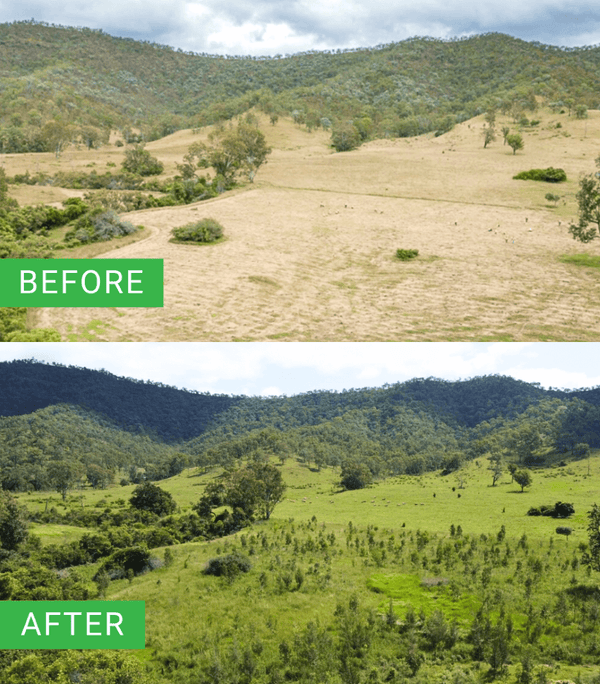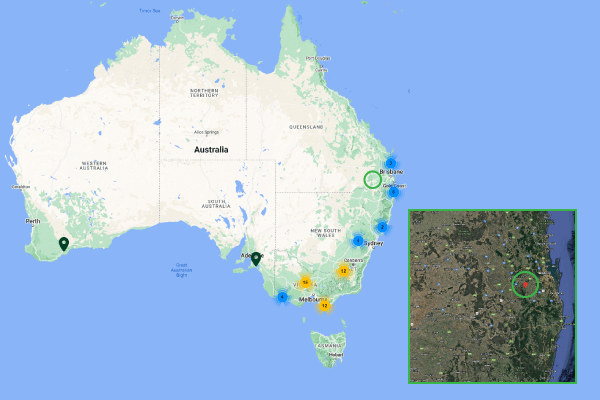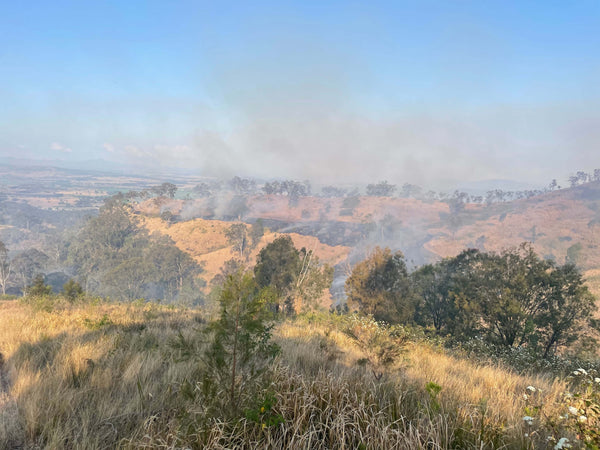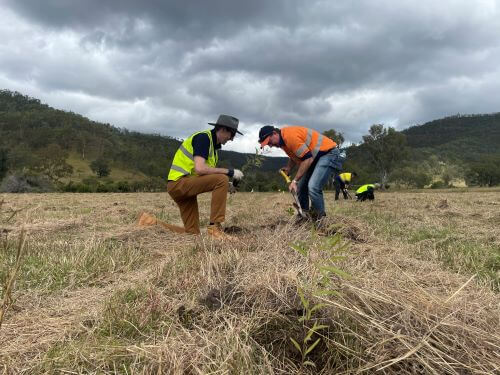
Bringing Together Ecosystem Restoration With Sustainable Agriculture To Build Habitat In South East Queensland
Located in South East Queensland, on Yuggera Country, the revegetation project at Aroona is restoring critical habitat for species such as koalas and native bats. Our restoration work at Aroona included a unique mix of ecological processes to suit the site, including cool burning, aerial seeding, and traditional planting practices. The revegetation of Aroona is also demonstrating how sustainable agriculture and climate action can effectively coexist.

Location And Overview
Aroona is a working cattle station located near Grandchester in South East Queensland. The 2,000-hectare property is owned by Queensland Trust for Nature (QTFN) and Greenfleet is working with them to restore the property and conserve biodiversity.
Greenfleet has a number of revegetation projects underway in South East Queensland including Koala Crossing, which is also restoring critical habitat for the local koalas. You can see where many of Greenfleet’s projects are growing here.

Ecological Cool Burn
In addition to Greenfleet’s traditional planting methodologies, we undertook an ecological cool burn at Aroona. This reinstates the burning regimes suited to particular ecosystems to stimulate the ecological health of the landscape and assist some of the seeds to germinate.
Functionally, an ecological cool burn aims to burn any understorey and groundcover vegetation that comes about a metre above the ground while leaving the forest midstorey and canopy un-scorched. It moves slowly through the landscape and ensures important native seeds and nutrients in the soil are not destroyed.
There are many benefits of undertaking this practice. In the appropriate ecosystem, a cool burn reduces weeds and overgrowth, can act as a fire management tool, provides an ash bed for seed germination, and helps create complex and resilient habitat.
At Aroona 40-60% of the landscape within the project area was burnt to create a patchwork of burnt and unburnt areas.
Species Selection & Revegetation Techniques
At Aroona, there are 16 Regional Ecosystems present that our Revegetation Team took into consideration when planning this project. Regional Ecosystems are vegetation communities that exist within a particular bioregion. They are characterised by consistent association with a particular combination of geology, landform, and soil.
70% of the property is covered in remnant vegetation and Greenfleet’s reforestation work is restoring cleared areas to reconnect pockets of existing forest. More than 30 native species have been planted at Aroona, including eucalypts and several rainforest species.
In conjunction with the ecological cool burn, aerial seeding was utilised to plant seeds after the burn event occurred. This technique entails a drone flying over the revegetation area to evenly disperse seed.
In addition to this technique, thousands of native seedlings were also planted at Aroona as part of Greenfleet’s traditional revegetation operations.
Building Wildlife Habitat
A critical benefit of our work at Aroona is building habitat for the region’s wildlife. Numerous species call this area home and will be able to find refuge and food sources in the trees as they become more established.
Many bird and wildlife species can be found in this area including Glossy Black Cockatoos, Brush-tailed Phascogales, and several glider species which are now considered endangered. The forest will also build habitat and provide food sources for koalas. In 2022, a koala was spotted in the revegetation area demonstrating the benefit this project will provide to the local populations.
Grey-headed Flying Foxes can also be found at this property. These animals are reliant on flowering trees so species we planted a variety such as Queensland Blue Gum (Eucalyptus tereticornis), and Narrow-leafed Ironbark (Eucalyptus crebra) to ensure flowering all year round and provide continuous food sources for the bats.
This revegetation work is also important for reconnecting habitat for the vulnerable Brush-tailed Rock-wallaby which takes refuge in the rocky high country that can be found throughout Aroona.

In Partnership With QTFN
The 2,000-hectare property was gifted to Queensland Trust for Nature (QTFN) by Robin and Kathleen Stocks progressively between 2015 and 2018. Since then, QTFN has established a nature reserve on the property in conjunction with Greenfleet’s revegetation operations.
Climate Action
Greenfleet’s ecosystem restoration work delivers climate action by building biodiverse forests that remove carbon from the atmosphere as they grow. The forest at Aroona is legally protected and will capture nearly 55,000 tonnes of CO2-e over its lifetime. This is the equivalent of what around 12,700 average vehicles emit in one year.
About Greenfleet
Greenfleet is an Australian not-for-profit environmental organisation protecting our climate by restoring our forests.
We plant native biodiverse forests to capture carbon emissions and help fight the impacts of climate change. Greenfleet is Australia’s first carbon offset provider and since 1997 has planted over 11.2 million trees creating more than 550 forests in Australia and New Zealand.
Our forests are legally protected for up to 100 years, conserving biodiversity, improving the health of our soils and waterways, and restoring habitat for wildlife, including many endangered species.
Greenfleet grows forests and climate hope by empowering people to take tangible and long-lasting environmental action.
Location Size
125 hectares in South-East Queensland
Planting Dates
2019, 2021, 2022
Species
- Acacia disparrima
- Acacia falcata
- Acacia fimbriata
- Acacia leiocalyx
- Acacia maidenii
- Allocasuarina littoralis
- Allocasuarina torulosa
- Angophora floribunda
- Angophora subvelutina
- Banksia integriflolia
- Brachichiton populneus
- Casuarina cunninghamiana
- Corymbia
- Corymbia clarksoniana
- Corymbia intermedia
- Corymbia tessellaris
- Eucalyptus crebra
- Eucalyptus melanophloia
- Eucalyptus melliodora
- Eucalyptus moluccana
- Eucalyptus tereticornis
- Gahnia
- Lophestemon confertus
- Lophestemon suaveolens
- Mallotus philippensis
- Melaleuca bracteate
- Melaleuca linariifolia
- Melaleuca trichostachya
- Melaleuca viminalis
- Pittosporum revolutum
- Psydrax odorata
- Waterhousea floribunda


